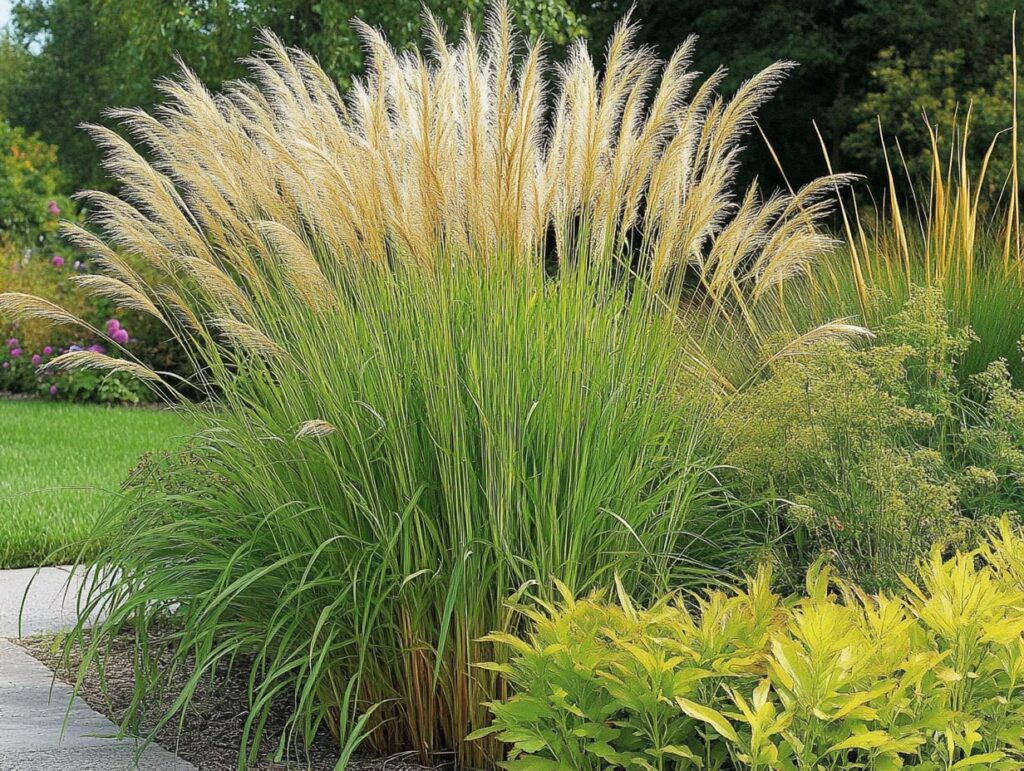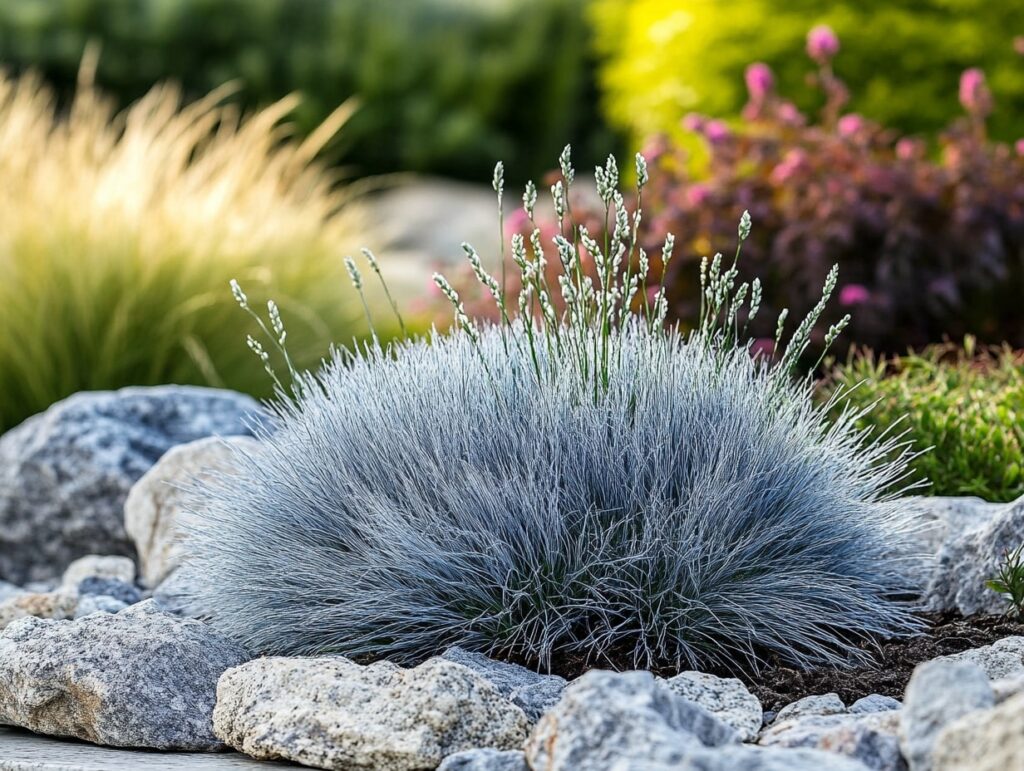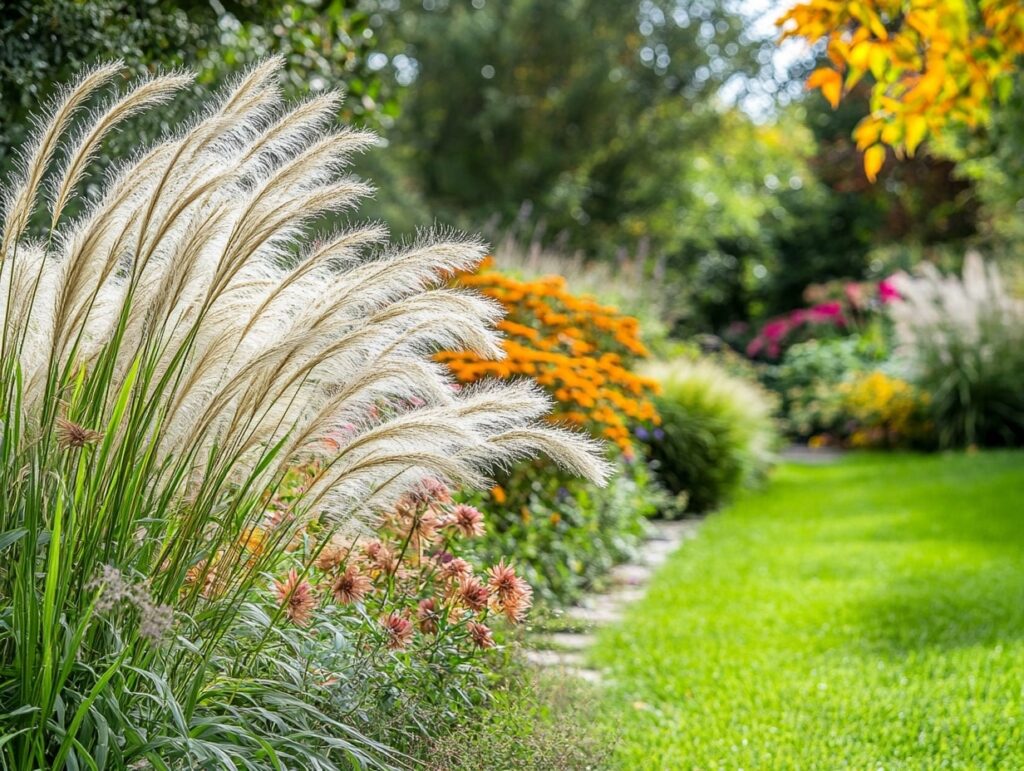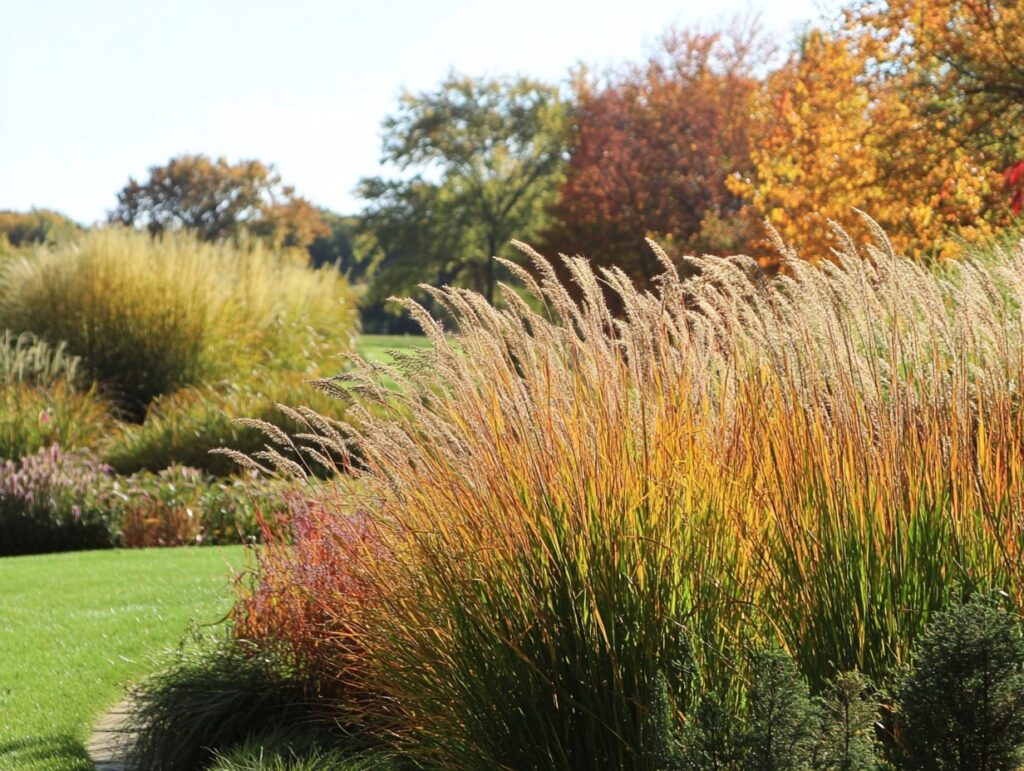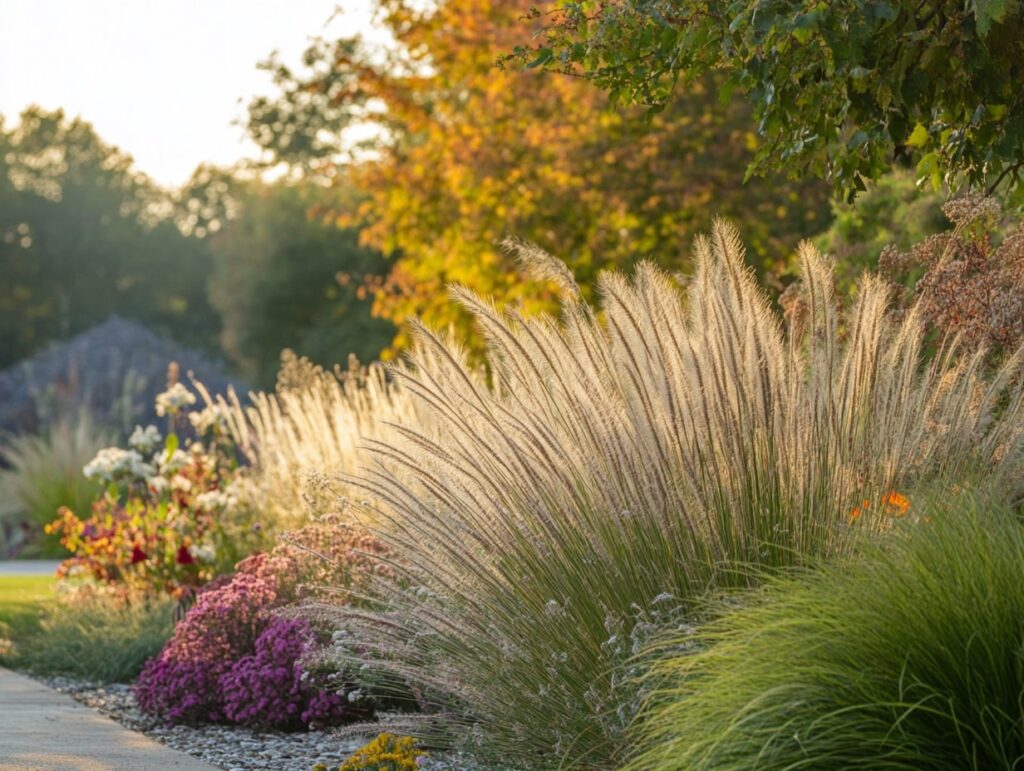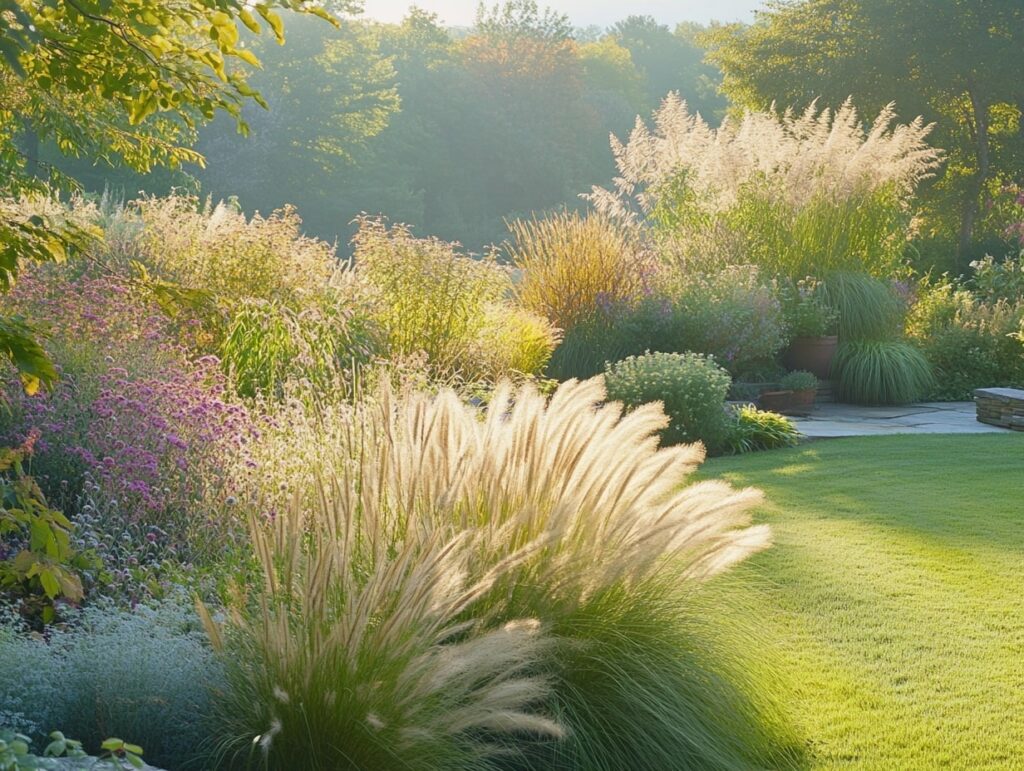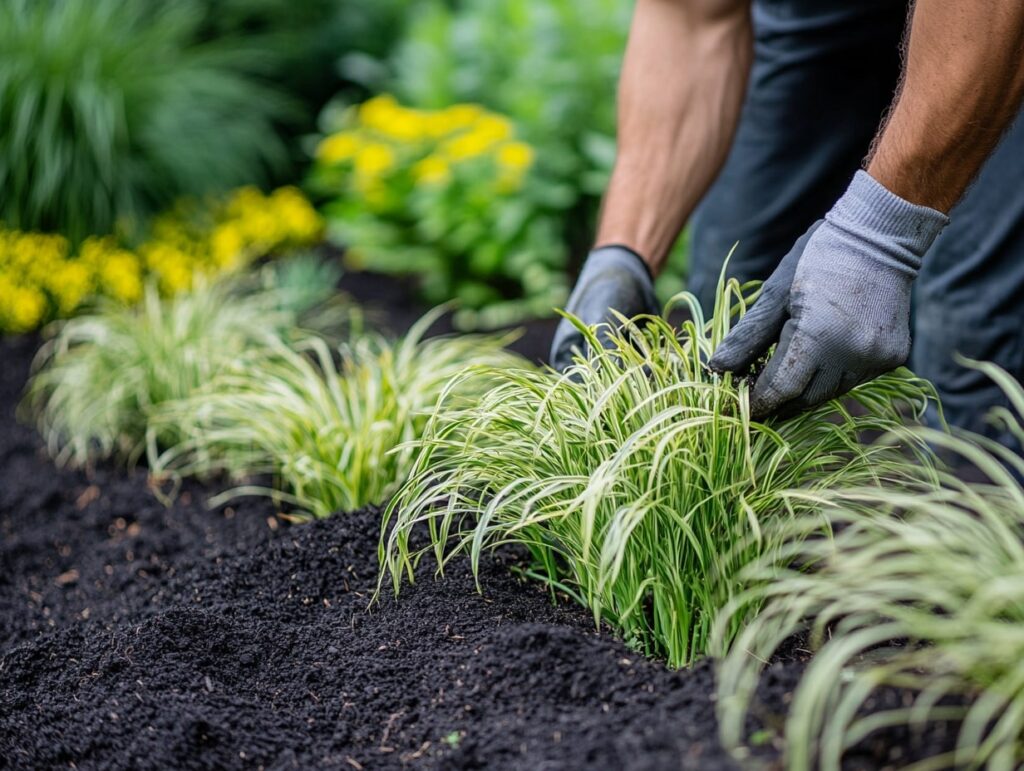Imagine a garden that dances with the breeze, shimmering with a symphony of textures and colors. Ornamental grasses can transform your landscape into a dynamic masterpiece with minimal effort.
These versatile plants not only add elegance and movement to any space but are also incredibly easy to grow and maintain.
Perfect for both beginners and seasoned gardeners, ornamental grasses come in an array of heights, hues, and styles to match your garden’s unique charm.
Dive into the world of ornamental grasses and discover how these resilient beauties can elevate your garden with their graceful presence and effortless care.
Types of Ornamental Grasses
Feather Reed Grass (Calamagrostis x acutiflora)
Feather Reed Grass is known for its tall, upright growth habit and feathery plumes that appear in early summer. The most popular variety is ‘Karl Foerster,’ which features narrow, green leaves and flower spikes that turn golden in fall.
Growing Conditions:
- Light: Full sun to partial shade
- Soil: Well-drained soil, tolerates a range of soil types
- Water: Moderate water needs; drought-tolerant once established
- Height: 4-6 feet
Best Uses: Ideal for adding vertical interest to borders, creating screens, and providing texture in mixed plantings. Feather Reed Grass is particularly effective when planted in groups.
Blue Fescue (Festuca glauca)
Blue Fescue is a compact, clump-forming grass known for its striking blue-gray foliage. It forms neat, dense tufts and produces inconspicuous flowers in late spring to early summer.
Growing Conditions:
- Light: Full sun
- Soil: Well-drained soil, prefers sandy or rocky soils
- Water: Low water needs; very drought-tolerant
- Height: 6-12 inches
Best Uses: Perfect for borders, rock gardens, and ground cover. Blue Fescue also works well in container plantings and as an edging plant.
Maiden Grass (Miscanthus sinensis)
Maiden Grass is known for its graceful, arching form and feathery flower heads that emerge in late summer to early fall. The flowers often turn into attractive plumes that persist into winter.
Growing Conditions:
- Light: Full sun to partial shade
- Soil: Moist, well-drained soil
- Water: Moderate water needs; drought-tolerant once established
- Height: 4-8 feet
Best Uses: Suitable for creating movement and softness in the landscape. It works well as a specimen plant, in mass plantings, or as a background plant in mixed borders.
Pampas Grass (Cortaderia selloana)
Pampas Grass is a large, robust grass known for its striking, fluffy plumes that can reach up to 12 feet in height. It has arching leaves with sharp edges, so handle with care.
Growing Conditions:
- Light: Full sun
- Soil: Well-drained soil; tolerates poor soils
- Water: Low to moderate water needs; drought-tolerant once established
- Height: 8-12 feet
Best Uses: Ideal for creating dramatic focal points in the garden. Pampas Grass is also effective as a screen or windbreak due to its height and density.
Switchgrass (Panicum virgatum)
Switchgrass is a tall, clump-forming grass with airy flower panicles that appear in late summer. Its foliage often turns beautiful shades of yellow, orange, and red in fall.
Growing Conditions:
- Light: Full sun to partial shade
- Soil: Well-drained to moist soils; tolerant of a wide range of soil types
- Water: Moderate water needs; drought-tolerant once established
- Height: 3-6 feet
Best Uses: Excellent for adding a prairie feel to gardens. It works well in mixed plantings, as a border plant, or in naturalistic landscapes and meadows.
Benefits of Ornamental Grasses
Ornamental grasses offer numerous benefits that make them a valuable addition to any garden:
- Low Maintenance: Most ornamental grasses require minimal care once established, making them ideal for busy gardeners.
- Drought Tolerance: Many grasses are drought-tolerant and can thrive in poor soil conditions, reducing the need for frequent watering.
- Year-Round Interest: With their evergreen varieties and beautiful seed heads, ornamental grasses provide visual interest throughout the year.
- Wildlife Friendly: Grasses offer habitat and food for various wildlife, including birds and beneficial insects.
- Erosion Control: Their extensive root systems help stabilize soil and prevent erosion.
Selecting the Right Ornamental Grasses
Selecting the right ornamental grasses involves understanding your climate, evaluating sunlight and soil conditions, and considering your design and aesthetic preferences. These steps will help ensure that your garden thrives and looks its best year-round.
Considering Climate and Zone
Your region’s climate significantly impacts which ornamental grasses will flourish. Ornamental grasses are categorized according to specific USDA hardiness zones.
Check your local zone to select species that are naturally suited to withstand your area’s seasonal temperatures.
For example, if you live in a cooler zone, grasses like Feather Reed Grass (Calamagrostis) tolerate frost well. On the other hand, Fountain Grass (Pennisetum) thrives in warmer zones. Additionally, consider moisture levels. Some grasses prefer wetter conditions, while others thrive in dry, arid regions.
Assessing Sunlight and Soil Conditions
Different ornamental grasses have varying requirements for sunlight and soil.
Determine whether your planting area receives full sun, partial shade, or full shade, and select grasses accordingly.
Full-sun grasses, like Switchgrass (Panicum virgatum), need at least six hours of sunlight. In contrast, Shade-loving grasses, such as Hakone Grass (Hakonechloa), grow well under trees or in shaded garden beds.
Soil type is equally important. Test your soil to understand its composition, whether sandy, loamy, or clay-heavy, and choose grasses that will thrive in those conditions.
For instance, Prairie Dropseed (Sporobolus heterolepis) prefers well-drained soil, while others may tolerate heavier, clayey soils.
Design and Aesthetic Preferences
Your garden’s design and your aesthetic preferences also play a crucial role in selecting ornamental grasses.
Consider the texture, color, and height of the grasses you wish to incorporate. Taller grasses like Miscanthus can serve as focal points or natural privacy screens, while shorter varieties like Blue Fescue (Festuca glauca) function well as border plants.
Mixing grasses with different bloom times ensures year-round interest. For a dynamic look, combine grasses with varying blade widths and colors.
Blue Oat Grass (Helictotrichon) adds a distinct blue hue, while Ruby Streaks (Pennisetum setaceum) provides a striking reddish-purple tint.
Planting Your Ornamental Grasses
Planting ornamental grasses requires selecting the right season, following a detailed planting guide, and proper spacing. Let’s dive into each aspect to ensure successful growth for your grasses.
Choosing the Correct Season for Planting
The best time to plant your ornamental grasses typically falls in spring or early fall.
Spring planting allows grasses to establish roots before the heat of summer, giving them a strong start. Spring is particularity good for warm-season grasses.
Fall planting works well for cool-season grasses, giving them time to develop roots before the cold hits. It’s also beneficial because the soil remains warmer than the air, encouraging root growth.
Avoid planting in extreme temperatures, either too hot or too cold, as this can stress the grasses. A mild, temperate climate is ideal for planting.
Step-by-Step Planting Guide
To successfully grow ornamental grasses, consider the following steps:
- Choosing the Right Location
- Most ornamental grasses prefer full sun to partial shade. Ensure the chosen location receives adequate sunlight based on the specific grass variety.
- Check the soil type and drainage. While many grasses tolerate poor soil, good drainage is essential to prevent root rot.
- Soil Preparation
- Amend the soil with organic matter, such as compost, to improve fertility and drainage.
- Conduct a soil test to determine pH levels. Most grasses thrive in slightly acidic to neutral soil (pH 6.0-7.0).
- Planting
- Plant grasses in spring or early fall when temperatures are moderate.
- Dig a hole twice the width of the root ball and as deep as the container. Place the plant in the hole, backfill with soil, and firm it gently.
- Water thoroughly after planting to settle the soil and eliminate air pockets.
- Watering
- Water newly planted grasses regularly until they are established, typically within the first growing season.
- Once established, most ornamental grasses are drought-tolerant and require minimal watering.
- Fertilizing
- Ornamental grasses generally do not need frequent fertilization. A light application of balanced fertilizer in spring can promote healthy growth.
- Avoid excessive fertilization, which can lead to weak, floppy growth.
Spacing and Arrangement Tips
Proper spacing is crucial for the health and appearance of your ornamental grasses.
Spacing depends on the type of grass. For small grasses, space them 12 to 24 inches apart. Larger varieties may need 24 to 36 inches of space.
Neglecting proper spacing can lead to overcrowding, which may increase the risk of disease and reduce air circulation.
Arrangement can dramatically impact your garden’s look.
Group grasses with similar growth habits and heights together for a harmonious appearance. Using grasses as borders or focal points can add structure and beauty to your garden.
By planning your arrangement carefully, you can create a visually appealing and healthy garden space.
Caring for Ornamental Grasses
Proper care ensures that ornamental grasses remain healthy and attractive:
1. Pruning and Maintenance
- Cut back deciduous grasses to about 4-6 inches above the ground in late winter or early spring before new growth begins.
- Remove dead or damaged foliage from evergreen grasses to maintain a tidy appearance.
- Divide overgrown clumps every 3-4 years in early spring to rejuvenate the plant and prevent overcrowding.
2. Mulching
- Apply a layer of mulch around the base of the plants to conserve moisture, suppress weeds, and regulate soil temperature.
- Use organic mulch, such as bark chips or straw, and avoid piling it directly against the plant stems to prevent rot.
3. Pest and Disease Control
- Ornamental grasses are generally pest-resistant. However, monitor for common issues like aphids, spider mites, and rust.
- Treat infestations with insecticidal soap or neem oil and remove any affected foliage.
4. Winter Protection
- Most ornamental grasses are hardy and can withstand winter conditions. However, in regions with severe winters, protect tender varieties with a layer of mulch or a burlap wrap.
- Avoid cutting back grasses too early in fall, as the foliage provides winter interest and insulation.
Designing with Ornamental Grasses
Ornamental grasses can enhance garden design in various ways:
- Borders and Edges
- Use low-growing grasses like Blue Fescue to define garden borders and edges. Their neat clumps provide structure and contrast against flowering plants.
- Focal Points
- Create focal points with tall, dramatic grasses like Pampas Grass or Maiden Grass. Their height and plumes draw attention and add vertical interest.
- Mixed Plantings
- Combine grasses with perennials, shrubs, and flowering plants to create dynamic, layered plantings. Grasses add texture and movement, complementing the form and color of other plants.
- Containers
- Plant grasses in large containers for patios and balconies. Choose compact varieties and pair them with seasonal flowers for a striking display.
- Meadows and Prairies
- Use a mix of grasses and wildflowers to create naturalistic meadows and prairies. Switchgrass and Feather Reed Grass are excellent choices for this purpose.
Ornamental grasses are a versatile and valuable addition to any garden. Their low maintenance, drought tolerance, and year-round interest make them ideal for both novice and experienced gardeners.
By understanding the types, benefits, and care requirements, you can successfully grow and enjoy these beautiful plants in your landscape.
Whether used as borders, focal points, or part of mixed plantings, ornamental grasses bring texture, movement, and a touch of nature to garden designs.

